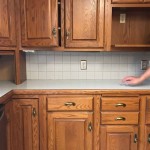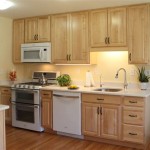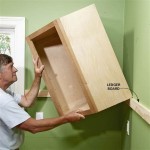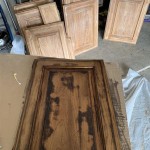How To Shine Dull Kitchen Cabinets
Kitchen cabinets, frequently exposed to grease, grime, and moisture, can lose their luster over time, resulting in a dull and unappealing appearance. Revitalizing these cabinets can significantly improve the overall aesthetic of the kitchen without the expense of full replacement. Several methods exist to restore shine to dull kitchen cabinets, ranging from simple cleaning routines to more intensive refinishing processes. The selection of the appropriate method depends on the type of cabinet finish, the extent of the dullness, and the desired level of restoration.
Before beginning any cleaning or restoration process, it is crucial to identify the type of finish applied to the cabinets. Common finishes include painted surfaces, varnished wood, laminate, and thermofoil. Each material reacts differently to cleaning agents and restoration techniques. Applying an inappropriate method can damage the finish, exacerbating the problem. Manufacturers' guidelines, if available, typically provide specific recommendations for cleaning and maintenance. Visual inspection can also offer clues. Painted cabinets often have a solid color and may show brushstrokes. Varnished wood cabinets exhibit a natural wood grain. Laminate cabinets are typically smooth and uniform in appearance. Thermofoil cabinets are usually seamless and have a plastic-like feel.
Proper preparation is essential for achieving optimal results. This involves removing all hardware, such as knobs, pulls, and hinges. This allows for thorough cleaning of the entire cabinet surface and prevents damage to the hardware. Labeling or organizing the hardware during removal simplifies reinstallation. Next, the surrounding area should be protected. Cover countertops and floors with drop cloths or plastic sheeting to prevent spills and splatters. Good ventilation is also important, especially when using cleaning agents or solvents. Open windows and doors, or use a fan to circulate air.
Basic Cleaning for Routine Maintenance
Regular cleaning is the first line of defense against dull kitchen cabinets. This removes surface dirt, grease, and grime that contribute to a lack of shine. A simple solution of warm water and mild dish soap is often sufficient for routine cleaning. Avoid using abrasive cleaners or scrub brushes, as these can scratch the finish. A soft cloth or sponge should be used to gently wipe down the cabinets. Pay particular attention to areas around the stove and sink, which are prone to grease and water stains.
For cabinets with a buildup of grease, a degreasing solution may be necessary. Several commercially available degreasers are specifically formulated for kitchen cabinets. Alternatively, a homemade solution of baking soda and water can be effective. Mix a paste of baking soda and water and apply it to the greasy areas. Let it sit for a few minutes, then gently scrub with a soft cloth or sponge. Rinse thoroughly with clean water and dry with a clean cloth. Avoid harsh chemicals, such as ammonia or bleach, as these can damage the finish and discolor the cabinets.
After cleaning, it is important to dry the cabinets thoroughly. Moisture can seep into the finish, causing damage over time. Use a clean, dry cloth to wipe down the cabinets immediately after rinsing. If the cabinets are particularly damp, consider using a dehumidifier or fan to speed up the drying process. Once the cabinets are dry, inspect them for any remaining dirt or grime. If necessary, repeat the cleaning process. Regular cleaning, even a quick wipe-down once a week, can significantly reduce the need for more intensive restoration methods.
Reviving Shine with Polishing Products
When basic cleaning is insufficient to restore shine, polishing products can be employed. These products typically contain oils and waxes that fill in minor scratches and imperfections, creating a smooth, reflective surface. The selection of the appropriate polishing product depends on the type of cabinet finish. For wood cabinets, furniture polish or cabinet wax is a suitable choice. For painted cabinets, a specialized paint polish or wax can be used. Laminate cabinets may benefit from a cleaner designed for non-porous surfaces.
Before applying any polishing product, it is crucial to test it in an inconspicuous area, such as the inside of a cabinet door. This will ensure that the product does not damage or discolor the finish. Follow the manufacturer's instructions carefully when applying the polishing product. Typically, a small amount of product is applied to a soft cloth and then rubbed onto the cabinet surface in a circular motion. Allow the product to dry for the recommended time, then buff with a clean, dry cloth to remove any excess residue. Repeat the process as necessary to achieve the desired level of shine.
Some polishing products contain ingredients that can be harmful if ingested or inhaled. It is important to use these products in a well-ventilated area and to wear gloves to protect the skin. Avoid getting the product in the eyes. If contact occurs, rinse thoroughly with water. Store polishing products out of reach of children and pets. Proper disposal of used cloths and applicators is also important. Follow the manufacturer's instructions for disposal to prevent environmental contamination.
Addressing More Significant Dullness: Refinishing
When cabinets exhibit significant dullness, scratches, or damage, refinishing may be necessary. Refinishing involves removing the existing finish, repairing any damage, and applying a new finish. This is a more intensive process than basic cleaning or polishing, but it can dramatically improve the appearance of the cabinets. Refinishing options range from simple touch-ups to complete stripping and re-staining or painting.
For cabinets with minor scratches or chips, touch-up paint or stain can be used to conceal the imperfections. This involves carefully applying the touch-up product to the damaged area with a small brush or applicator. Match the color of the touch-up product to the existing finish as closely as possible. Allow the touch-up product to dry completely before applying a clear coat to protect the repaired area. Touch-up is most effective for small, isolated areas of damage.
For cabinets with more extensive damage or significant dullness, complete stripping and refinishing may be required. This involves removing all hardware and preparing the work area. The existing finish is then removed using chemical strippers, sanding, or a combination of both. Chemical strippers can be effective for removing multiple layers of finish, but they require careful handling and proper ventilation. Sanding is often necessary to smooth the surface and remove any remaining residue. Once the old finish is removed, any necessary repairs can be made, such as filling holes or cracks with wood filler. The cabinets are then primed and painted or stained. Multiple coats of paint or stain may be necessary to achieve the desired color and coverage. Finally, a clear coat is applied to protect the finish and enhance its durability.
Refinishing is a time-consuming and labor-intensive process. It is important to have the necessary skills and equipment before attempting to refinish kitchen cabinets. If unsure, consider hiring a professional to ensure a satisfactory result. Proper surface preparation is key to a successful refinishing project. This includes thorough cleaning, sanding, and priming. The quality of the finish depends on the quality of the materials used. Choose high-quality paints, stains, and clear coats for optimal results. Always follow the manufacturer's instructions for application and drying times.
Even after implementing these methods, the long-term maintenance and prevention of dullness are essential. This includes consistent cleaning habits, using appropriate cleaning products, protecting cabinets from excessive moisture and heat, and addressing minor damages promptly. Regularly clean spills and splatters to prevent staining and buildup. Use trivets and pot holders to protect cabinet surfaces from hot pots and pans. Repair scratches and chips as soon as they occur to prevent further damage. By taking these preventative measures, the shine of the kitchen cabinets can be maintained for years to come.

How To Clean Kitchen Cabinets Everyday Skate

The Best Way To Clean Kitchen Cabinets

How To Clean Grimy Kitchen Cabinets With 2 Ingredients

How To Clean Painted Kitchen Cabinets By Kayla Payne

How To Properly Clean Your Wood Cabinets So They Shine Trends Finishing

Kitchen Cabinets Too Shiny Hometalk

Tips To Avoid A Dull Cabinet Finish And Make Yours Shine N Hance Of Jacksonville

How To Clean Grimy Kitchen Cabinets With 2 Ingredients

How To Polish Kitchen Cabinets Cabinet Now

The Ultimate Guide To Cabinet Care Doors N More
Related Posts








